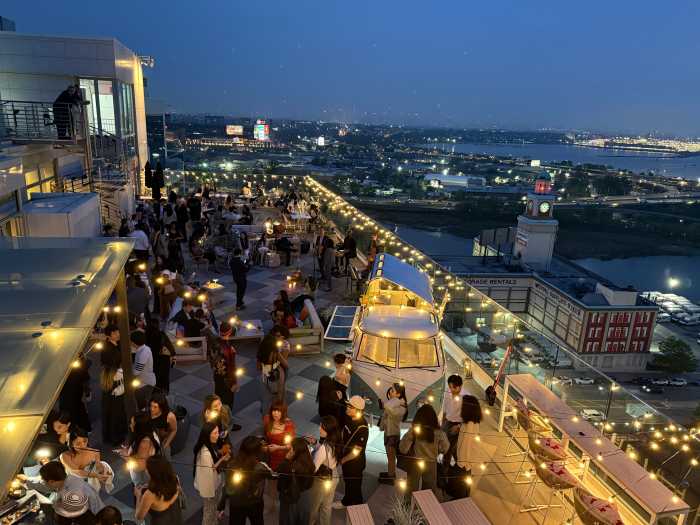
Phase 3 Construction (DOT)
Oct. 30, 2019 By Allie Griffin
The majority of Queens council members voted today in favor of a plan that will bring hundreds of miles of protected bicycle and bus lanes to city streets.
The legislation introduced by Council Speaker Corey Johnson passed the full council by a 35 to 10 vote with two abstentions. The $1.7 billion plan will add 250 miles of protected bike lanes and 150 miles of bus lanes as well as other bus and pedestrian priority measures over a 5 year period beginning in 2022.
Council Members Jimmy Van Bramer, Costa Constantinides, Donovan Richards, Daniel Dromm and Antonio Reynoso were strong supporters of the plan. Each were listed as co-sponsors. Meanwhile, Council Members Karen Koslowitz, Francisco Moya, Peter Koo, Rory Lancman and Barry Grodenchik voted in favor of it.
Council Members Robert Holden, Paul Vallone and I. Daneek Miller were the only three from Queens to vote down the plan. Holden and Vallone said that their districts were in transit deserts where residents have no other options but to drive vehicles. Queens only Republican Council Member Eric Ulrich abstained from the vote.
Johnson created the plan in response to a spike in cyclist deaths this year. Year-to-date, 25 cyclists have been killed on city streets— the highest toll in at least a decade, according to city data.
“The way we plan our streets makes no sense and New Yorkers pay the price every day on slow buses, biking on streets with no bike lanes, or walking on streets without enough sidewalk space,” Johnson said in a statement last month. “Far too often New Yorkers pay the price for our poorly designed streets with their lives.”
Johnson’s sweeping plan, which has Mayor Bill de Blasio’s support, aims to make New York’s streets safer for pedestrians and cyclists as well as speed up buses.
The plan would require the implementation of “transit signal priority” at 1,000 intersections each year. With transit signal priority, traffic signals are programmed to turn green when buses approach.
In addition, the master plan would require the DOT to upgrade 500 bus stops a year; add accessible pedestrian signals at 2,500 intersections over course of the 5-year plan; assess and amend commercial loading zones and truck routes; develop parking policies to improve safety; and create one million square feet of pedestrian space by the end of 2023.
“My master plan bill will revolutionize the way we plan our streets and will bring our city into the 21st century in terms of prioritizing mass transit users, pedestrians, and cyclists over private automobiles,” Johnson said last month.
The DOT is tasked with creating the five-year master plan by Dec. 1, 2021, with it taking effect the following year.
The legislation also requires the DOT to implement a new transportation master plan every five years with new benchmarks added each time. The next plan would be due in 2026 and would include the completion of a protected bike lane network among other measures.
The passage of Johnson’s plan comes at a time in Queens when road redesigns have proven to be controversial.
For instance, the redesign of Queens Boulevard has not generated universal support, with opponents arguing that it has cut the number of parking spaces, hurt businesses and lead to congestion.
Phase IV of the Queens Boulevard plan, which will go from Yellowstone Boulevard to Union Turnpike when completed, was rejected by Community Board 6 in 2018, with Council Member Karen Koslowitz also opposed to it.

Phases of Queens Boulevard Redesign (DOT) The first three phases have been completed
Despite the opposition, the DOT said it was going to complete Phase IV last summer. The agency has yet to begin work and supporters of the plan have held rallies calling on the city to construct it.
Advocates argue that the changes need to be made to reduce traffic deaths, which should be the priority.
Likewise, Queens Community Board 2 voted down the installation of protected bike lanes and other traffic measures along Skillman and 43rd Avenues in Sunnyside in June 2018. Despite their disapproval, the DOT moved forward with that plan and completed the bike lanes that fall. More than 120 parking spaces have since been removed.
Bicycle and pedestrian advocates–as well as Council Member Jimmy Van Bramer–say the Sunnyside plan has been a success and the roadways are much safer.
5 Comments






Love the bike lanes. old cranks can be angry about this. Hey over it or just leave for Florida
Cyclists should carry insurance just like cars
More bike lanes just give a place for delivery trucks and impatient drivers to park, leaving my frustrated on my bike. Just let cars destroy themselves in traffic while i zip on by.
If you drive on Queens Blvd. from off the 59th Street Bridge all the way down to Jamaica, you MAY see 1/2 a dozen bicyclists and those are food delivery guys! The city has spent a fortune (paid by DRIVERS!) on bike lanes for people who don’t need a license (don’t pay NYS), don’t have to pay for registration (don’t pay NYS), don’t have to pay for inspection (don’t pay NYS), don’t pay for gas (don’t pay NYS) and, more importantly, don’t pay the high cost of insurance! Then again neither do the immigrants that NYS is allowing to get driver’s licenses without any documents, while the rest of us, even to renew, have to show birth certificate, old license, proof of address, and other papers! I hope when Sasquatch leaves City Hall, the new Mayor gets rid of the people at DOT and buys a lot of paint to get rid of the bike lanes. Making only 1 lane on the side streets for cars, buses, ambulances, firetrucks, etc. is beyond dangerous and stupid!
Bring on the death of quiet communities. Sunnyside used to be quiet and beautiful. Now you can’t distinguish it from Corona with the snarling traffic that has been created. 65st Queens Blvd. in Woodside has become a paralyzed mess. I particularly love how Van Branner and his crew do not incorporate the voices of the affected communities who have businesses on those streets that cannot receive deliveries without causing a blockade, or residents who have lost street parking and on top of that have to now deal with the incessant honking generated by the unavoidable traffic jam. And we wonder why NY leads the list of people fleeing the state to other states.